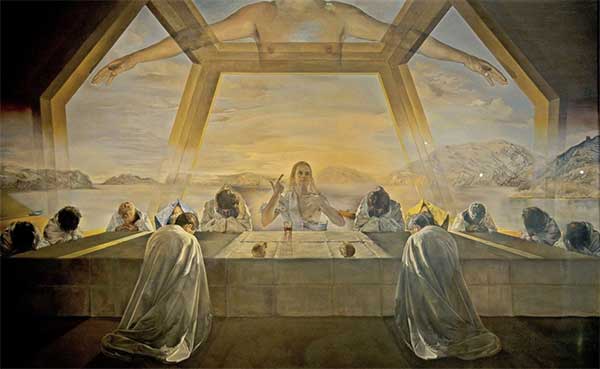By John Anthony S. Estolloso
ENTER THE refectory of the retreat house at St. Clement’s Church and you would be greeted by a well-rendered copy of one of most notable pieces of modern religious art: Salvador Dalí’s The Sacrament of the Last Supper.
Dalí, the great champion of Surrealist Art, was a paradox of his time. His well-publicized involvement in the modern European art scene and its bohemian circles were nothing short of profligate. One need but look at his masterpieces to understand the vastness of this libertine joie de vivre that the artist espoused and unabashedly projected into the psyche of his artworks.
It was only during the waning years of the artist that he slowly looked back to religion, and as if to make up for lost time, commenced the painting of religious scenes and subjects, providing the artworld with some of the finest masterpieces of modern religious art: counting among these are the numerous distorted iterations of the Madonna, the unconventional bird’s-eye perspective of a crucified St. John of the Cross, and of course, his version of the Last Supper.
While it is customary for Filipino families to display an image of this scriptural scene in dining rooms or eateries, they would usually opt for the more traditional portrayal of the event, preferably one patterned or cut to the version of Leonardo da Vinci’s mural: the complete dramatis personae in dramatic poses, with Christ at the center of the mise-en-scène.
Finished in 1955, Dalí’s interpretation of this scene deviates from this conventional imagery. Faithful to surrealist modes, he had no qualms in coalescing images in an attempt to reiterate visually the theological (and liturgical, perhaps) aspects of the Last Supper.
Sprawled across the canvas is the supper table, which Dalí subtly portrays covered with a cloth, the folds of which sharply stand out, achieving the optical effect of something akin to an altar-stone: more than a supper, this is also a sacrifice. With the artwork’s most prominent element alone, Dalí – with all his controversial Catholicity – establishes the connection between Christ’s final meal with the institution of the Mass: the breaking of bread at the Last Supper becomes the breaking of divine flesh at the Crucifixion.
To further emphasize this corporeal transubstantiation, he juxtaposes a naked corpus with open arms over the central figure of Christ. There is no cross; only geometric borders that seem to evoke the architecture of ecclesiastical structures.
This superimposition with the seemingly crucified body envisages the words of the eucharistic consecration, even as the viewer is directed to the broken loaf of bread symmetrically placed side-by-side on the table. ‘For this is My Body’ thus transcends ritual performative: here is transubstantiation understood through an artist’s eyes.
Surrounding the table are kneeling figures, presumably the apostles in postures of reverence and veneration. What is striking is the manner they are clothed: cowled and covered, almost like the traditional copes and chasubles worn traditionally by priests. As if to reinforce the apostolicity of the holy orders, Dalí lets surface the background through these foregrounded figures: a vast lake where small fishing boats are drawn towards the figure of Christ, as if to visually echo the mandate and mission of the priesthood: Ye shall be fishers of men…
Despite being a most excellent replica, a closer look at the St. Clement’s copy provides interesting points of differentiation. For one, the choice of color palette tends to lean more to cooler hues, with browns and blues predominating the canvas, a stark contrast to the warm earthy ochres used by Dalí in the original. Also obscured to fleeting glances are the copyist’s initials and the year of rendition, tucked in the bottom left corner of the canvas: P. Antolo after S. Dalí… Iloilo ’68.
Further inquiries about the identity of P. Antolo revealed him to be a respectable local copyist of works of famous artists, counting among them Juan Luna and Félix Resurrección Hidalgo. Patricio Antolo (his full name) was known to have provided local establishments with well-rendered copies of masterpieces, some of which are displayed at the local Catholic seminary.
*****
The next time you attend a retreat at St. Clement’s, drop by their refectory and spend a few moments with Salvador Dalí’s painting: read between the images, find the Divine in the surreal mix, and contemplate the magnum mysterium in the canvas.
(The author is the subject area coordinator for Social Studies in one of the private schools of the city.)






















